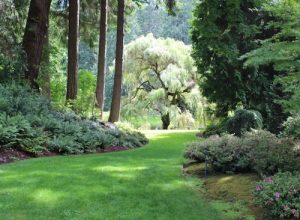Environmentally Friendly Lawn Care
By Carmine Carosella, Fairfax Master Gardener
Lawns, we either love them or hate them. They are things of beauty, enhancing our homes and landscape beds while providing space for recreation. But so much work and, some say, not good for the environment. I come down on the love-side of the issue. But I also want to maintain a lawn and, at the same time, do it in the most environmentally friendly way as possible.

A beautiful lawn enhances any landscape
Well, here are some do’s and don’ts for lawn care. First and most important is fertilizer application. Always use a nitrogen fertilizer that is at least 50 percent slow release. Many commercial fertilizers have 20 percent slow release or less. Not good. By law, manufacturers must label their bags with the percentage of slow and fast release nitrogen. Fast release fertilizers lead to runoff of excess nitrogen and promote lush top-growth which results in more mowing. Nitrogen fertilizer is most effectively applied in the Fall to cool season grasses, when the major root growth of lawns occurs. This ensures a healthy lawn the following Spring. Slow release fertilizer will ensure that the lawn has a steady diet of nitrogen throughout the root growing season. Of course, any fertilizer should not be applied right before a forecast of heavy rain. Also, keep fertilizer off streets and sidewalks to avoid runoff into streams. Finally, slow release nitrogen fertilizers tend to cost more per pound of nitrogen, but last longer, require less applications and are more environmentally friendly.
Now, let’s attack the weed issues. First, remember that the best weed control is a healthy, thick lawn kept mown at 3 inches high. And remember, a few weeds really do not destroy the appearance of a lawn! Generally, there are two types of weeds, annual and perennial. Annual weeds that grow from seeds in the soil are most easily controlled with a pre-emergent. The two glaring examples of annual weeds are crabgrass in sunny lawns and Japanese stiltgrass in shady lawns. A pre-emergent barrier in the soil will keep them from sprouting. The chemical dithiopyr gives effective pre-emergent control of Summer weeds when applied as a granular powder in late March. Since it works in the ground, it is considered very safe to pets and people. This is a much safer solution to weed control compared with post-emergent, above-ground treatments for growing weeds. Dithiopyr is available in the commercial product, DIMENSION.
Perennial weeds present more difficult problems, since they must be treated above ground. Hand pulling is possible but not always effective or practical. Spray treatment with an herbicide mixed with a surfactant is the best approach. A do-it-yourself person could spot spray just the troublesome weeds. Most lawn care companies don’t have time to spot spray; they would just spray the entire lawn. An effective broadleaf herbicide to use contains a mixture of chemicals 2,4-D; Dicamba; MPP and Carfentrazone. It is available in the commercial product, SPEED ZONE.
Finally, there are many other lawn issues, such as pests and diseases which I have not addressed. Most of these are passing problems that resolve themselves. For example, brown patch, the most common fungal disease in our region, goes away in the cool Fall weather. Keeping your lawn properly cut at 3 to 4 inches high is a key to eliminating many weed and fungal problems. Note that this past, wet Summer, many of the area golf courses lost their short-cut fairways due to fungus attacks while the taller cut rough did just fine!
To summarize, having a beautiful lawn requires work. Most important is proper fertilizer application. Fall application of at least 50 percent slow release nitrogen is the best approach. The pH of the soil should be between 6.2 and 7.0 for the fertilizer to work properly; measure your pH and adjust as necessary. Pre-emergent control of annual weeds is the best approach. Remember though, you can’t put down grass seed until several months after you apply a pre-emergent. Perennial weeds present more difficult problems. Hand-pulling and spot herbicide treatment are the best ways to control them.
References
2018 VA Pest Management Guide, Lawn, Chapter 5
The Lawn Bible, David R. Mellor, ISBN 0-7868-8842-3, Hyperion Books, NY 2003